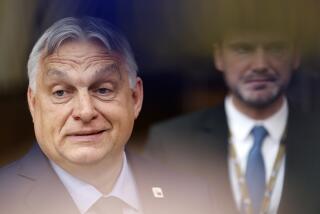Can Hungary’s New Leaders Now Take the ‘Next Steps’ and Bring True Pluralism?
- Share via
It is now two down and one, two or three to go.
Ousted less than a week before his 76th birthday, Hungarian Communist Party chief Janos Kadar is the second East European leader to have been dismissed in recent months. The first to go was Czechoslovakia’s Gustav Husak, who was eased out last December. Bulgaria’s Todor Zhivkov, in power since 1954, is expected to follow them soon, but it will be more difficult to replace East Germany’s Erich Honecker and, especially, Romania’s Nicolae Ceausescu with men more attuned to Soviet leader Mikhail S. Gorbachev’s policies and leadership style.
Unlike the rest, and despite his ignominious early role as Moscow’s henchman after the Soviet Union had crushed the 1956 Hungarian revolution, Kadar was a major figure in East European communism.
Having pioneered the first major economic reform in the Warsaw Pact in 1968, Kadar had hoped to retire after his party’s next Congress in 1990 as the founding father of “goulash communism”--or Hungary’s Lenin. Alas, his humiliating ouster now assures that his successors will instead portray him as a leader who lost touch with political reality in his old age--or as the Hungarian Brezhnev. They have already deprived him of his seat in the ruling politburo.
The irony is that during his career, Karoly Grosz, the 57-year-old new party chief, has not displayed Gorbachev’s commitment to radical reform, but only the Soviet leader’s dynamism and public-relations skills. In the 1970s and even as late as a year or two ago, Grosz’s political mentality appeared to resemble that of Yegor Ligachev, the No. 2 man in the Kremlin and Gorbachev’s conservative competitor. Until recently, Grosz was seen as a Ligachev in Gorbachev’s clothes.
But the composition of the new Hungarian politburo indicates that Grosz, out of conviction or otherwise, is now on Gorbachev’s team. In particular, the elevation of Imre Pozsgay, known as Hungary’s Gorbachev, and the reinstatement of Rezso Nyers, a radical reform economist who was ousted from the politburo by Kadar in the mid-1970s, suggest that Hungary might resume its once-pioneering role in trying to reform a stagnating communist system.
It will be a most difficult task for the new leaders to accomplish. Grosz has inherited a country whose economic problems are more serious than at any time since the reforms began in the late 1960s. Hungary’s per-capita Western debt, for example, is the highest in Eastern Europe, even higher than Poland’s. The economy has not grown for years, the level of investment and the standard of living have declined and inflation has taken off. With an economy that cannot let go of central planning and yet encourages the play of market forces as well, Grosz is left with a hodgepodge that combines the worst of both worlds.
Meanwhile, the country’s political atmosphere reflects the people’s growing impatience with half-measures. Most Hungarians are no longer burdened by the defeatist “ ’56 complex”--the memory of the 1956 revolution that was crushed by Soviet forces. They want more than “democratization,” more than political handouts. They want pluralism. They would also like a Hungarian leader to ask Gorbachev: If the Soviet army can pull out of Afghanistan, why could it not leave Hungary, too?
In short, they want both more goulash and less communism.
For some time to come, Grosz is not likely to be able to satisfy such high expectations. What needs to be done--the “reform of the reform”--is currently unthinkable. The next step for the sake of political stability, for example, would require Hungary to move toward genuine pluralism and eventually toward the adoption of a two-party system--even if both parties were to accept the country’s socialist orientation and uphold its association with the Warsaw Pact. Only then could the people be persuaded to undertake the necessary sacrifices to make the economy work.
The main problem is that Hungary is already years ahead of the Soviet Union in terms of both perestroika and glasnost ; the “next steps” would entail racing still further ahead.
Yet in the longer run there is reason to be cautiously optimistic. Unlike Kadar in his old age, Grosz at least understands the problem. Some of his new politburo allies, especially Pozsgay and Nyers, have publicly stated over and over again that their country’s economic problems cannot be overcome without radical political change. They favor Hungary’s becoming the first Warsaw Pact country in which “socialist pluralism” is not a slogan but part of a broader, long-term accommodation with political reality.
In addition, Gorbachev’s own policies are very much on the line in Hungary. Because “goulash communism” was a harbinger of perestroika and because Kadar’s slogan of the 1960s--”He who is not against us is with us”--anticipated glasnost , Hungary has become an important part of ongoing Soviet debates about the wisdom of Gorbachev’s reforms. Gorbachev thus has much to gain from the success, and even more to lose from the failure, of the Hungarian reform experience.
Hence the larger question is whether Grosz’s promotion signals a Soviet interest in allowing Hungary to take those critical “next steps” beyond perestroika and glasnost . If Hungary is to embark on the admittedly dangerous but ultimately rewarding road to genuine political pluralism, will its experience prove the viability of reform or the inherent incompatibility of communism and democracy?
More to Read
Sign up for Essential California
The most important California stories and recommendations in your inbox every morning.
You may occasionally receive promotional content from the Los Angeles Times.













